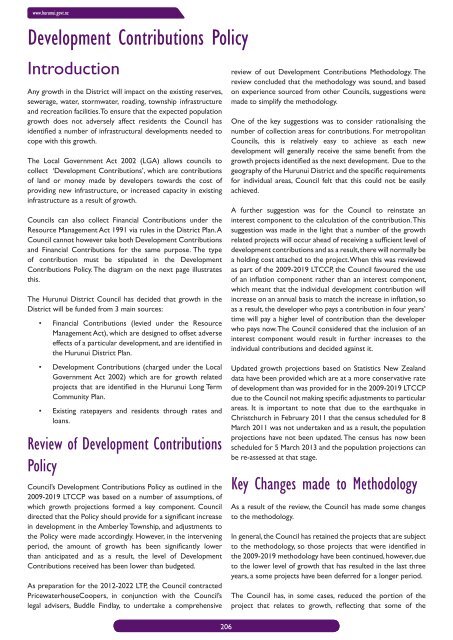DRAFT LTP book.indb - Hurunui District Council
DRAFT LTP book.indb - Hurunui District Council
DRAFT LTP book.indb - Hurunui District Council
You also want an ePaper? Increase the reach of your titles
YUMPU automatically turns print PDFs into web optimized ePapers that Google loves.
www.hurunui.govt.nzDevelopment Contributions PolicyIntroductionAny growth in the <strong>District</strong> will impact on the existing reserves,sewerage, water, stormwater, roading, township infrastructureand recreation facilities. To ensure that the expected populationgrowth does not adversely affect residents the <strong>Council</strong> hasidentifi ed a number of infrastructural developments needed tocope with this growth.The Local Government Act 2002 (LGA) allows councils tocollect ‘Development Contributions’, which are contributionsof land or money made by developers towards the cost ofproviding new infrastructure, or increased capacity in existinginfrastructure as a result of growth.<strong>Council</strong>s can also collect Financial Contributions under theResource Management Act 1991 via rules in the <strong>District</strong> Plan. A<strong>Council</strong> cannot however take both Development Contributionsand Financial Contributions for the same purpose. The typeof contribution must be stipulated in the DevelopmentContributions Policy. The diagram on the next page illustratesthis.The <strong>Hurunui</strong> <strong>District</strong> <strong>Council</strong> has decided that growth in the<strong>District</strong> will be funded from 3 main sources:• Financial Contributions (levied under the ResourceManagement Act), which are designed to offset adverseeffects of a particular development, and are identifi ed inthe <strong>Hurunui</strong> <strong>District</strong> Plan.• Development Contributions (charged under the LocalGovernment Act 2002) which are for growth relatedprojects that are identifi ed in the <strong>Hurunui</strong> Long TermCommunity Plan.• Existing ratepayers and residents through rates andloans.Review of Development ContributionsPolicy<strong>Council</strong>’s Development Contributions Policy as outlined in the2009-2019 LTCCP was based on a number of assumptions, ofwhich growth projections formed a key component. <strong>Council</strong>directed that the Policy should provide for a signifi cant increasein development in the Amberley Township, and adjustments tothe Policy were made accordingly. However, in the interveningperiod, the amount of growth has been signifi cantly lowerthan anticipated and as a result, the level of DevelopmentContributions received has been lower than budgeted.As preparation for the 2012-2022 <strong>LTP</strong>, the <strong>Council</strong> contractedPricewaterhouseCoopers, in conjunction with the <strong>Council</strong>’slegal advisers, Buddle Findlay, to undertake a comprehensivereview of out Development Contributions Methodology. Thereview concluded that the methodology was sound, and basedon experience sourced from other <strong>Council</strong>s, suggestions weremade to simplify the methodology.One of the key suggestions was to consider rationalising thenumber of collection areas for contributions. For metropolitan<strong>Council</strong>s, this is relatively easy to achieve as each newdevelopment will generally receive the same benefi t from thegrowth projects identifi ed as the next development. Due to thegeography of the <strong>Hurunui</strong> <strong>District</strong> and the specifi c requirementsfor individual areas, <strong>Council</strong> felt that this could not be easilyachieved.A further suggestion was for the <strong>Council</strong> to reinstate aninterest component to the calculation of the contribution. Thissuggestion was made in the light that a number of the growthrelated projects will occur ahead of receiving a suffi cient level ofdevelopment contributions and as a result, there will normally bea holding cost attached to the project. When this was reviewedas part of the 2009-2019 LTCCP, the <strong>Council</strong> favoured the useof an infl ation component rather than an interest component,which meant that the individual development contribution willincrease on an annual basis to match the increase in infl ation, soas a result, the developer who pays a contribution in four years’time will pay a higher level of contribution than the developerwho pays now. The <strong>Council</strong> considered that the inclusion of aninterest component would result in further increases to theindividual contributions and decided against it.Updated growth projections based on Statistics New Zealanddata have been provided which are at a more conservative rateof development than was provided for in the 2009-2019 LTCCPdue to the <strong>Council</strong> not making specifi c adjustments to particularareas. It is important to note that due to the earthquake inChristchurch in February 2011 that the census scheduled for 8March 2011 was not undertaken and as a result, the populationprojections have not been updated. The census has now beenscheduled for 5 March 2013 and the population projections canbe re-assessed at that stage.Key Changes made to MethodologyAs a result of the review, the <strong>Council</strong> has made some changesto the methodology.In general, the <strong>Council</strong> has retained the projects that are subjectto the methodology, so those projects that were identifi ed inthe 2009-2019 methodology have been continued, however, dueto the lower level of growth that has resulted in the last threeyears, a some projects have been deferred for a longer period.The <strong>Council</strong> has, in some cases, reduced the portion of theproject that relates to growth, refl ecting that some of the206
















